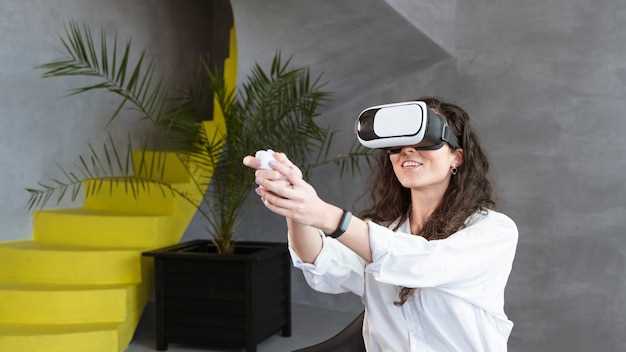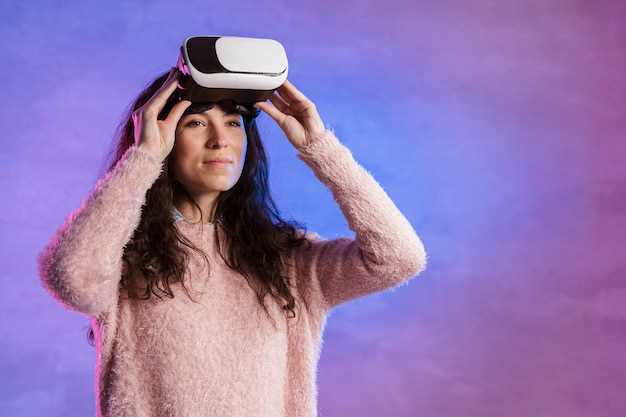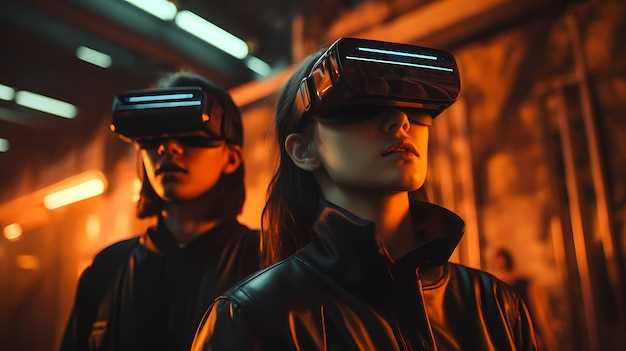Imagine a world where gaming, education, and work exist in a digital layer overlaid on our physical environment. Picture yourself exploring realms that are not bound by physical constraints. Such experiences are no longer figments of science fiction. We are on cusp of an era where boundaries between real and digital blur. This realm offers new possibilities previously thought unattainable.
The digital overlay can transform daily routines into adventures. Interactive education methods can make learning far more engaging. Remote work? It becomes immersive. Meetings are held within rich, 3D environments, transcending geographical limits. Businesses find new ways to showcase products. Consumers experience them from their own space.
These advancements promise more than just entertainment. Healthcare industry sees potential in training simulations. Imagine surgeons practicing techniques in realistic, risk-free environments. Therapeutic applications might revolutionize patient care. The implications are vast. Such transformations herald a new era in human interaction and productivity.
Economic sectors are also evolving. Real estate, tourism, and retail stand to gain enormously. Virtual tours replace traditional open houses. Shoppers try before they buy without stepping into stores. This interconnected digital world integrates into our daily lives seamlessly. Industries continue to innovate, driven by these profound changes.
We are at threshold of a fascinating journey. It is reshaping how we perceive our surroundings. Embrace it. Future is here, and it is boundless.
The Rise of Augmented and Virtual Reality
The digital frontier is expanding at an unprecedented rate. New immersive experiences are emerging daily. Imagine worlds that blend seamlessly with our own. These innovations are not just for gamers. They are transforming industries and daily life.
Today, creative applications span from entertainment to education. Medical professionals now use immersive simulations for training. Real estate agents offer interactive property tours. Retailers let customers try before they buy. The possibilities are endless. Every day we see new and exciting uses.
Pioneering companies are investing heavily in this sector.Startups to tech giants are vying for supremacy. They’re pushing boundaries and overcoming limitations. This competition fuels rapid advancements. Breakthroughs are occurring at a dizzying pace.
Early adopters are reaping significant benefits. Businesses streamline their operations with advanced tools. Customers relish richer, more engaging experiences. In this digital renaissance, every innovation brings us closer to a fully immersive world. The momentum shows no signs of slowing down.
Historical Development and Milestones
Let’s dive into the past and explore how these phenomenal concepts evolved. The journey spans decades, filled with innovation and groundbreaking discoveries. Early dreams paved the way for today’s reality. It’s a story of inventors, visionaries, and game-changers. Each milestone is a testament to human ingenuity. Convergence of various fields spurred progress, propelling us forward. From rudimentary beginnings to sophisticated modern systems, it’s been one heck of a ride. Buckle up as we traverse this fascinating timeline!
In the 1960s, Morton Heilig introduced a multisensory simulator named Sensorama. It was ahead of its time, enveloping users in a full sensory experience. Then, Ivan Sutherland’s “The Sword of Damocles” emerged in 1968, pioneering a new frontier. Moving forward, 1970s computer-generated worlds started getting attention. Disney’s Epcot Center produced entertaining and educational experiences using new technology.
Stepping into the 1980s, Jaron Lanier coined a now-common term and founded VPL Research. His team developed early versions of gloves and headsets. At the same time, Tom Caudell introduced innovative training models. The 1990s saw significant leaps, including Sega’s simulators and the much-anticipated Nintendo Virtual Boy. By the end of the decade, IEEE officially recognized milestones in this field, cementing its place in technological history.
| Year | Milestone |
|---|---|
| 1962 | Morton Heilig creates Sensorama |
| 1968 | Ivan Sutherland presents “The Sword of Damocles” |
| 1985 | Jaron Lanier coins the term and founds VPL Research |
| 1995 | Nintendo releases the Virtual Boy |
The dawn of the 21st century brought game-changing improvements. Companies like Google and Microsoft revolutionized personal and professional applications. Meanwhile, the entertainment industry leveraged these advancements, bringing unparalleled experiences to the masses. From gaming to healthcare, the impact has been profound, forever altering various sectors.
Today, we continue to witness rapid advancements. Startups and major corporations alike push boundaries. Exciting projects consistently emerge. As we look back, we see a trajectory moving unequivocally forward. The horizon promises even more remarkable achievements. This journey is far from over, with endless possibilities awaiting us.
Current Market and Future Trends
The current market for immersive experiences is booming. Companies are investing heavily. Consumers are showing increased interest. Both high-tech and low-cost solutions are emerging. Even small startups are getting involved. The landscape is dynamic and fast-paced. Major players are not shying away. This is not just a phase; it’s becoming a staple in various industries, from gaming to real estate. Innovations are constant, and the demand keeps growing.
The appeal of these immersive experiences is diverse. It extends far beyond entertainment. Educational institutions are adopting it for interactive learning. Healthcare providers use it for training and patient care. Marketing agencies leverage it for unique customer engagement. Clearly, this is a versatile field.
Looking ahead, the trends indicate even greater developments. Integration with other cutting-edge tech, like AI and machine learning, is expected to escalate. Devices are becoming more affordable. User interfaces are improving for better accessibility. Moreover, data security and user privacy are gaining attention, leading to more robust solutions. Industry forecasts suggest that this market will grow exponentially over the next decade.
| Year | Projected Market Size (in billion USD) |
|---|---|
| 2023 | 30 |
| 2025 | 50 |
| 2030 | 100 |
Emerging trends also point towards more collaborative environments. Remote work tools are incorporating these immersive elements. Virtual offices are becoming mainstream. People are likely to embrace these changes, especially as they seek more engaging remote interactions. Personal virtual spaces might soon replace traditional social media platforms.
Applications of Augmented Reality
Unleashing the potential of merging physical and digital worlds brings us numerous possibilities. Imagine enhancing your daily experiences in novel ways. This innovation isn’t just for entertainment. Professionals across industries leverage it for solving real-world problems. Think beyond gaming and explore its broader impacts. Our environments are becoming more interactive and intuitive.
Healthcare Revolution

In medicine, interactive overlays provide essential benefits. Surgeons get comprehensive visual aids during operations. Medical students use it for realistic practice. Patient care is evolving with more accurate diagnostics. Virtual consultations make healthcare more accessible. Hospitals can better manage resources.
Educational Transformation

Learning becomes more dynamic and engaging. Historical events can be visualized as if happening now. Complex theories make sense through interactive explanations. Field trips are replaced with immersive experiences. Students can explore anatomy in a hands-on manner. It’s changing the way knowledge is imparted.
- Enhanced navigation systems for drivers and pedestrians
- Interactive advertising capturing consumer attention
- Maintenance and repair guidance with step-by-step instructions
- Virtual try-ons in fashion and retail
- Real-time translation of signs and texts for travelers
In summary, merging our physical world with rich digital content opens up endless possibilities. Industries from healthcare to education to retail are transforming. The tools we use are becoming smarter and more intuitive. Embrace this evolution. It promises to make our lives richer and more connected.
Enhancements in Education and Training
The ways we learn are evolving rapidly. Old methods are becoming obsolete. New methods are more engaging. They provide immersive experiences. This helps learners grasp complex concepts easily. By immersing students in a controlled environment, they experience hands-on learning without real-world risks. This transformation is more impactful than ever.
Interactive Lessons

Interactive classes revolutionize traditional education. Students participate actively. They no longer just listen passively. They’re involved in a dynamic learning process. Such lessons are effective. Studies show increased retention rates. When learners interact directly, they comprehend faster. This method engages their senses. As a result, students are more motivated. They find learning enjoyable.
Simulated Training Environments
Training in simulated settings is a game changer. Trainees practice without real-world consequences. These environments are safe. Mistakes become opportunities for learning. Fields like aviation and healthcare benefit greatly. Pilots can train through flight simulations. Medical professionals perform virtual surgeries. They gain confidence without risking lives. It accelerates skill acquisition. Trainees are better prepared for real-world challenges.
Transformations in Retail and Marketing
Shoppers’ experiences have evolved dramatically in recent years. Modern methods have revolutionized how consumers interact with brands. Physical and digital worlds blend, creating immersive shopping adventures. It’s no longer just about browsing shelves or websites. A new layer of interaction elevates customer engagement.
Interactive Shopping Experiences
Customers can now try on clothes without stepping into a fitting room. Gone are days of endless queues. This innovation saves time and enhances convenience. Merchandise can be viewed in one’s personal space from any angle. With this, retailers can offer an unparalleled preview of their products. This not only boosts sales but also reduces returns and dissatisfaction.
Personalized Marketing Strategies
Marketers are leveraging these futuristic tools to craft unique campaigns. Tailored content can be delivered on a highly individualized basis. It ensures the right message reaches the right audience at optimal moments. Traditional advertisements are taking a back seat. Instead, personalized experiences captivate the consumer. This approach turns casual browsers into loyal customers. It provides invaluable insights into consumer behavior and preferences, allowing for continuous improvement in marketing efforts.
In summary, these transformations are setting new standards in retail and marketing. They offer a competitive edge, drive brand loyalty, and foster deeper connections with customers. The landscape is swiftly changing, and businesses must adapt to stay relevant. Embracing these innovations promises a prosperous future.
Innovations in Healthcare and Surgery
Modern medicine is on the brink of a revolution. New advancements are paving the way for safer and more effective medical procedures. These innovations are transforming how doctors and surgeons approach their work. Accuracy is improving. Patient outcomes are better. Lives are being saved. With these new tools, healthcare professionals are able to plan and execute complex procedures with greater confidence, ensuring that patients receive the best possible care.
The integration of advanced visualization tools in hospitals has been a game-changer. Surgeons can now practice operations in a simulated environment before ever touching a patient. This allows for perfection of techniques. Mistakes can be avoided. Learning curves are reduced. During actual surgery, these tools provide real-time guides for the surgeon’s instruments, leading to unprecedented levels of precision. This not only increases the success rate of surgeries, but also reduces recovery times and post-operative complications for patients.
Moreover, medical training has reached new heights. Students and residents are benefiting from immersive environments that closely mimic real-life situations. This type of hands-on experience is invaluable. It provides a depth of understanding that textbooks cannot offer. Future doctors are more prepared and confident. They enter the operating room with experience that used to take years to accumulate. The medical field is rapidly evolving, driven by these new practices.
In diagnostic fields, these advanced tools are proving indispensable. Complex data can be visualized in ways that make trends and anomalies more apparent. Conditions that were once hard to detect can now be identified earlier. Treatment plans are tailored more precisely. As a result, patient care is becoming more personalized. The ability to interact with data in new ways is revolutionizing diagnostics, leading to earlier and more accurate interventions.
All of these advancements contribute to a healthcare system that is more efficient, effective, and compassionate. The intersection of technology and medicine holds promise like never before. We are witnessing a transformation that will benefit both practitioners and patients. Long-term, these changes are set to redefine what is possible in medical science and surgery. The implications for public health are profound, promising a new era of enhanced medical outcomes.
Exploring Virtual Worlds
Stepping into digital landscapes opens up unique experiences unimaginable before. Every corner holds a new adventure. Characters and environments seem almost tangible. Users can interact with these creations, bringing immersion to an entirely new level.
Immersion and Interaction
In digital worlds,immersionstands out as a core aspect. The line between fiction and reality blurs. This deep dive offers an escape from the mundane. It feels almost natural, as if one is part of a story.
Interactions within these spaces are intuitive. Gestures and movements translate seamlessly. You can explore cities, ride dragons, or dive into oceans without leaving your room. Such capabilities expand our horizons, offering limitless possibilities for learning, gaming, and socializing.
Future Innovations
Developers continuously push boundaries of digital experiences. New methods emerge, enhancing both visuals and interactivity. Concepts once deemed science fiction are now within reach. Imagine, exploring ancient civilizations or uncharted planets with a mere headset.
Looking ahead, these advancements will likely touch every facet of life. They promise richer storytelling, more engaging education, and innovative ways to connect. As these worlds evolve, so too will our understanding and appreciation of these boundless realms.
Video:
Augmented Reality: The Future is Here!
Augmented Reality: The Future is Here! by KnowTechMafia 50 views 2 days ago 4 minutes, 50 seconds
Q&A:
What are the key differences between Augmented Reality (AR) and Virtual Reality (VR)?
Augmented Reality (AR) and Virtual Reality (VR) are both immersive technologies but differ fundamentally in their interaction with the real world. AR overlays digital content onto the real world, enhancing your current environment with elements such as images, sounds, and text. This is commonly experienced through devices like smartphones or AR glasses. On the other hand, VR creates a completely immersive digital environment that shuts out the physical world, usually experienced through VR headsets. With VR, users are transported to a completely different setting, giving experiences like gaming, virtual excursions, and high-level simulations a more immersive feel.
How is Augmented Reality used in everyday applications?
Augmented Reality is increasingly becoming part of our daily lives through a variety of practical applications. One of the most common uses is in navigation apps, where AR can overlay directions and points of interest onto the real-world view seen through a smartphone camera. In retail, AR allows users to visualize how products will look in their homes, such as furniture or decor items. Additionally, AR is used in education for interactive learning experiences, in healthcare for enhanced imaging and diagnostics, and in entertainment for immersive gaming experiences. By enhancing real-world environments with virtual elements, AR provides new ways of interacting with our surroundings and accessing information.
Can VR be used for purposes other than gaming? If so, how?
Absolutely! While gaming is one of the most popular applications of Virtual Reality, its potential extends far beyond entertainment. In education, VR provides immersive learning experiences, such as virtual field trips and interactive lessons on complex subjects. In the field of medicine, VR is used for surgical simulations, allowing practitioners to practice procedures in a risk-free environment. Additionally, VR technology has applications in real estate by offering virtual property tours, in employee training through realistic emergency response simulations, and in mental health for therapeutic interventions like exposure therapy for phobias. The versatility of VR makes it a valuable tool in various industries.
What are the current limitations of AR and VR technologies?
Despite their impressive capabilities, AR and VR technologies face several limitations. For AR, issues like limited field of view, lower processing power on mobile devices, and the need for high accuracy in overlaying virtual images on real-world objects pose challenges. VR, while offering more immersive experiences, is often hindered by high costs of equipment, the potential for motion sickness, and the requirement for a tethered setup to a powerful computer for high-quality experiences. Both technologies are also limited by battery life and ergonomic comfort during extended use. Furthermore, as these technologies collect and process a large amount of user data, privacy and security concerns remain significant issues that need addressing.